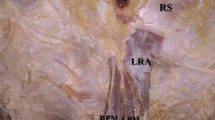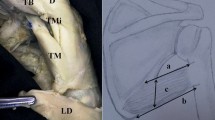Abstract
Introduction
The present study examined the morphology and morphometric parameters of the pyramidalis muscle (PM) in detail with their potential applicability in making midline infra-umbilical incisions and biomechanics of the linea alba.
Methods
PM was examined in 51 formalin-fixed cadavers (36 males and 15 females), and based on the mode of insertion or the level of apex, the formation or shape of the muscle was classified into nine types (Mori’s classification).
Results
Bilateral PM was more prevalent (39.21%) than unilateral (1.96%) (p = 0.001). All the cases showed side symmetry except one. Mori’s type 7 (right PM is higher apex and the left PM with elongated origin) was the most common form. The mean length of PM in males and females was 4.51 ± 0.14 and 3.33 ± 0.12 cm on the right and 4.51 ± 0.11 and 3.26 ± 0.16 cm on the left side. The mean width of right-sided PMs in males and females was 1.90 ± 0.17 and 1.58 ± 0.13 cm and left-sided 1.88 ± 0.14 and 1.55 ± 0.38 cm. The mean of pyramidalis–pubo-umbilical index (PPI) in males and females was 32.82 ± 1.65 and 27.50 ± 1.08, respectively. The mean insertion angle was 24.56 ± 3.07 on right side and 23 ± 2.03 on the left side (p = 0.03). Male predominance existed on right- and left-sided PM length (p < 0.001 and p < 0.001), width (p = 0.001) and PPI (p = 0.001). The strong positive correlation (r = 0.83) between length and width indicates a symmetrical muscle augmentation in the two dimensions.
Conclusion
PM is an inconsistent anatomical structure with persistent morphology. The level and angle of insertion into the linea are crucial in the biomechanics of linea alba. PPI, determining the termination level would be useful to surgeons making midline infra-umbilical incisions.



Similar content being viewed by others
Availability of data and materials
All data are presented in the manuscript.
References
Adachi B (1909) Beiträge zur Anatomie der Japaner. XII. Die Statistik der Muskelvarietäten. Z Für Morphol Anthropol 12:261–312
Ancel P (1901) Documents receuillies à la salle de dissection de la Fac. de Médecine de Nancy. Bibliogr Anatom 9:133–160
Chang C (1955) Some observations on the pyramidalis muscle. Acta Anat Sin 6. https://pesquisa.bvsalud.org/portal/resource/pt/wpr-560852
Cirocchi R, Cheruiyot I, Henry BM et al (2021) Anatomical variations of the pyramidalis muscle: a systematic review and meta-analysis. Surg Radiol Anat 43(4):595–605
Das SS, Saluja S, Vasudeva N (2017) Biometrics of pyramidalis muscle and its clinical importance. J Clin Diagn Res. https://doi.org/10.7860/JCDR/2017/24179.9276
Deeken CR, Lake SP (2017) Mechanical properties of the abdominal wall and biomaterials utilized for hernia repair. J Mech Behav Biomed Mater 74:411–427. https://doi.org/10.1016/j.jmbbm.2017.05.008
Dickson MJ (1999) The pyramidalis muscle. J Obstet Gynaecol 9(3):300. https://doi.org/10.1080/01443619965138
Didia B, Loveday O, Christian I (2009) Variation and frequency of agenesis of the pyramidalis muscles in Nigerian males. J Exp Clin Anat. https://doi.org/10.4314/jeca.v8i1.48031
Garvey JF (2012) Computed tomography scan diagnosis of occult groin hernia. Hernia 2012:307–314. https://doi.org/10.1007/s10029-011-0899-5
Goss CM (1948) Fasciae and muscles of the abdomen. Gray’s anatomy, 29th edn. Lea & Febiger, Philadelphia, pp 424–427
Haba D, Emura K, Watanabe Y et al (2018) Constant existence of the sensory branch of the nerve to the pyramidalis distributing to the upper margin of the pubic ramus. Anat Sci Int 93(4):405–413. https://doi.org/10.1007/s12565-018-0428-z
Hojaij FC, Kogima RO, Moyses RA (2020) Morphometry and frequency of the pyramidalis muscle in adult humans: a pyramidalis muscle’s anatomical analysis. Clinics (Sao Paulo) 75:e1623. https://doi.org/10.6061/clinics/2020/e1623
Jeong W, Lee S, Kim J (2018) Meta-analysis of flap perfusion and donor site complications for breast reconstruction using pedicled versus free TRAM and DIEP flaps. Breast 38:45–51. https://doi.org/10.1016/j.breast.2017.12.003
Kaur H, Singla RK, Brar RS et al (2016) Study of the morphometry of the pyramidalis muscle and its incidence in the Indian population. Int J Anat Res 4(2):2207–2211. https://doi.org/10.16965/ijar.2016.179
Kipkorir V, Olabu B, Ongeti K et al (2021) Prevalence and pubo-umbilical index of pyramidalis muscle in a select Kenyan population. Surg Radiol Anat 43(9):1461–1466. https://doi.org/10.1007/s00276-021-02733-6
Koulouris G (2008) Imaging review of groin pain in elite athletes: an anatomic approach to imaging findings. AJR Am J Roentgenol 191:962–972. https://doi.org/10.2214/AJR.07.3410
Landuyt KV, Hamdi M, Blondeel P, Monstrey S (2003) The pyramidalis muscle free flap. Br J Plast Surg 56:585–592. https://doi.org/10.1016/s0007-1226(03)00211-x
Le Double AF (1897) Traité des Variations du Système Musculaire de l’Homme et de Leur Signification au Point de vue de l’Anthropologie, Zoologique, vol 2. Scheicher Frères, Paris
Loth E (1919) Anthropomorphologie des muscles. Bull Mem Soc Anthropol Paris 10(1):116–133
Lovering RM, Anderson LD (2008) Architecture and fiber type of the pyramidalis muscle. Anat Sci Int 83(4):294–297. https://doi.org/10.1111/j.1447-073X.2007.00226.x
Malcic Gürbüz J, Özdoğmuş Ö, Yüksel M (2001) Unusual rectus abdominis and pyramidalis muscles: clinical significance-a case report. Marmara Med J 14(2):107–109
Matushima H (1927) Beitrage zur Muskelvarietaten. Kliniker Klinik Bd 4:34–37 (cited by Mori)
Michalska A, Rokita W, Wolder D, Pogorzelska J, Kaczmarczyk K (2018) Diastasis recti abdominis—a review of treatment methods. Ginekol Pol 89(2):97–101. https://doi.org/10.5603/GP.a2018.0016
Montagu AMF (1939) Anthropological significance of the musculus pyramidalis and its variability in man. Am J Physical Anthopol 15:435–490
Mori M (1964) Statistics on the musculature of the Japanese. Okajimas Folia Anat Jpn 40:195–300. https://doi.org/10.2535/ofaj1936.40.3_195
Natsis K, Piagkou M, Repousi E et al (2016) Morphometric variability of pyramidalis muscle and its clinical significance. Surg Radiol Anat 38(3):285–292. https://doi.org/10.1007/s00276-015-1550-4
Poth EJ (1960) A basic concept in the use of the rectus-pyramidalis sheath and transplants in the repair of hernias. Surg Gynecol Obstet 111:514–516
Ranjan R, Taru M, Lakshmi S (2014) Pyramidalis muscle variations pattern study: qualitative study. Ind J Basic and Appl Med Res 4(1):541–543
Schilders E, Bharam S, Golan E et al (2017) The pyramidalis-anterior pubic ligament-adductor longus complex (PLAC) and its role with adductor injuries: a new anatomical concept. Knee Surg Sports Traumatol Arthrosc 25(12):3969–3977. https://doi.org/10.1007/s00167-017-4688-2
Skandalakis L, Skandalakis J (eds) (2014) Surgical anatomy and technique a pocket manual, 4th edn. Springer-Verlag, New York, p p113
Skręt-Magierło J, Soja P et al (2015) Two techniques of pyramidalis muscle dissection in Pfannenstiel incision for cesarean section. Ginekol Pol 86(7):509–513. https://doi.org/10.17772/gp/57840
Standring S, Borley NR, Gray H (2008) Gray’s anatomy: the anatomical basis of clinical practice, 40th edn. Elsevier, Edinburgh
Sumalatha S, Rao S, Ankolekar VH (2022) prevalence and variations of the pyramidalis muscle in adults and fetuses: relevance and clinical implications. J Pharm Negat Results 3(10):197–204. https://doi.org/10.47750/pnr.2022.13.S10.18
Sumino Y, Hirata Y, Hanada M, Akita Y, Sato F, Mimata H (2011) Long-term cryopreservation of pyramidalis muscle specimens as a source of striated muscle stem cells for treatment of post-prostatectomy stress urinary incontinence. Prostate 71(11):1225–1230. https://doi.org/10.1002/pros.21338
Tokita K (2006) Anatomical significance of the nerve to the pyramidalis muscle: a morphological study. Anat Sci Int 81(4):210–224. https://doi.org/10.1111/j.1447-073X.2006.00148.x
Tomita A (1937–1939) Study on the M. pyramidalis. Kyushu Igakusenmongakko Igakkai Zasshi (Cited by Mori)
Vadgaonkar R, Prameela MD, Murlimanju BV et al (2018) Morphometric study of the semitendinosus muscle and its neurovascular pedicles in South Indian cadavers. Anat Cell Biol 51(1):1–6. https://doi.org/10.5115/acb.2018.51.1.1
Vallois HV (1926) Valeur et signification du muscle pyramidal de l’abdomen. Arch Anat Histol Embryol 5:497–525
Wagenseil F (1927) Muskelbefunde bei Chinesen. Verh Ges Phys Anthrop Anthropol Anz Stuttgart 2:42–50
Funding
Non funded.
Author information
Authors and Affiliations
Contributions
NBP: project development, literature review, data analysis, manuscript writing. AP: literature review, manuscript writing. KSR: manuscript writing, manuscript editing. SV: manuscript editing and critical revision. KP: manuscript editing and critical revision. MCS: manuscript editing and critical revision. Approval of the final version of the manuscript: all authors.
Corresponding author
Ethics declarations
Conflict of interest
The authors declare no competing interests.
Additional information
Publisher's Note
Springer Nature remains neutral with regard to jurisdictional claims in published maps and institutional affiliations.
Rights and permissions
Springer Nature or its licensor (e.g. a society or other partner) holds exclusive rights to this article under a publishing agreement with the author(s) or other rightsholder(s); author self-archiving of the accepted manuscript version of this article is solely governed by the terms of such publishing agreement and applicable law.
About this article
Cite this article
Pushpa, N.B., Patra, A., Ravi, K.S. et al. Reappraisal of the anatomical diversities of the pyramidalis muscle with their potential clinical applicability: cadaveric analysis. Surg Radiol Anat 46, 203–210 (2024). https://doi.org/10.1007/s00276-023-03278-6
Received:
Accepted:
Published:
Issue Date:
DOI: https://doi.org/10.1007/s00276-023-03278-6




